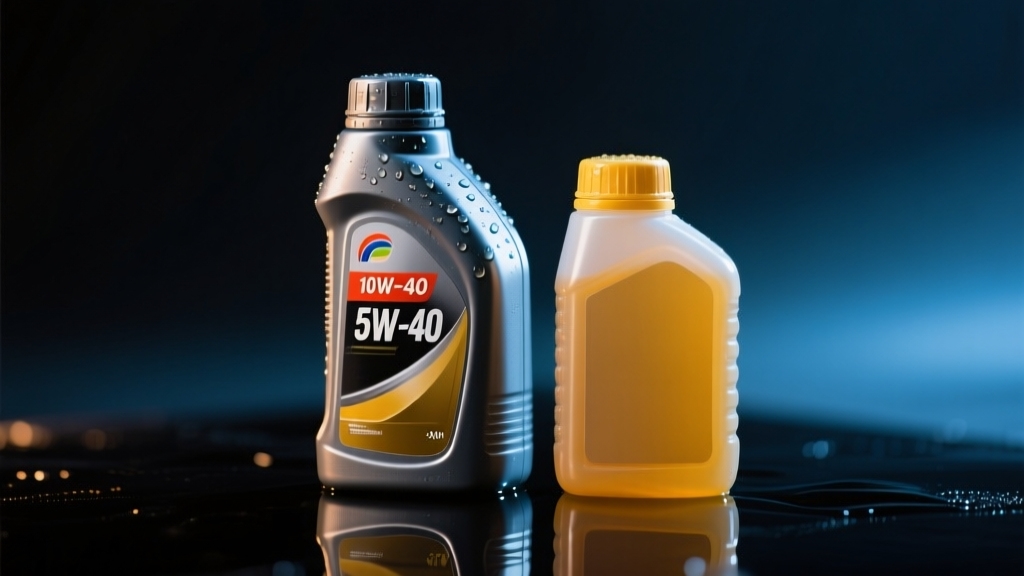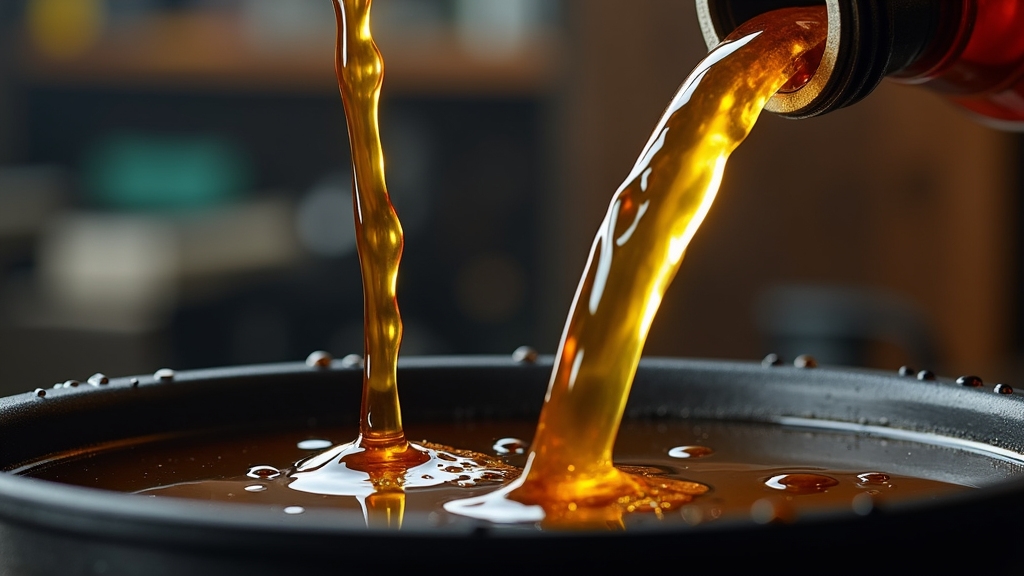Physical Address
304 North Cardinal St.
Dorchester Center, MA 02124
Physical Address
304 North Cardinal St.
Dorchester Center, MA 02124

You’ll find 5W-40 excels in cold start flow and high-temperature protection, maintaining a thicker lubricating film under stress and heat. It is ideal for harsh climates or aggressive driving. Meanwhile, 10W-30 offers better fuel efficiency with lower cold viscosity but may thin out in extreme heat.
Choosing the right oil depends on your engine’s needs, climate, and driving style. Understanding these factors guarantees peak performance and durability. Deeper insights are available on balancing these trade-offs effectively.
| Characteristic | 5W-40 | 10W-30 |
|---|---|---|
| Cold Start Performance | Superior flow in freezing temperatures | Good flow in moderate cold conditions |
| High Temperature Protection | Excellent – maintains thick lubricating film | Good but may thin under extreme heat |
| Fuel Economy | Slightly lower due to higher viscosity | Better – reduced engine drag |
| Climate Suitability | Extreme climates and temperature fluctuations | Moderate climates with stable temperatures |
| Driving Style Match | Aggressive driving and high-stress conditions | Moderate driving and highway cruising |
| Engine Protection | Superior under load and stress | Adequate for standard operating conditions |
| Oil Change Intervals | Potentially longer due to stability | Standard intervals recommended |
| Cost Consideration | Generally more expensive | More economical option |
| Turbo Engine Compatibility | Excellent for turbocharged engines | Suitable for naturally aspirated engines |

When you compare 5W-40 and 10W-30 oils, understanding their viscosity ratings is essential because these numbers directly affect how the oil performs under different temperature conditions.
The “5W” and “10W” indicate cold temperature flow, with 5W oil flowing more easily during startup than 10W, enabling quicker lubrication of engine parts. This improved cold flow is especially important for protecting the engine during cold weather startups, regardless of the climate.
Additionally, oils with lower W ratings enhance flow characteristics, reducing engine wear in colder environments. The second number—40 versus 30—represents the oil’s thickness at operating temperature. 5W-40 is denser, providing a more robust oil film that better protects engine components under heat and stress.
This higher viscosity at elevated temperatures helps maintain thermal protection and reduces friction during severe operating conditions. Choosing between these grades means balancing cold-start fluidity against high-temperature protection, depending on your engine’s demands and climate.
Although both 5W-40 and 10W-30 oils serve to lubricate engines at startup, 5W-40 delivers superior cold start performance due to its lower winter viscosity rating. This enables faster oil circulation and quicker pressure build-up in freezing temperatures, reducing engine wear during initial ignition.
Consider these critical factors:
Since engines operating under high temperatures demand robust lubrication, selecting an oil with adequate viscosity and thermal stability is critical for protection. 5W-40 offers a higher viscosity at operating temperature, creating a thicker lubricating film that better prevents metal-to-metal contact under heat and heavy loads.
Its superior film strength helps maintain lubrication on piston rings and bearings, reducing wear. Choosing the right viscosity involves balancing wear protection with fuel efficiency, considering engine design and operating conditions. High zinc content in synthetic oils like 5W-40 further enhances anti-wear protection during these demanding conditions.
Additionally, 5W-40’s full synthetic base typically provides enhanced oxidation resistance, minimizing sludge and varnish buildup. In contrast, 10W-30’s lower viscosity can thin excessively, weakening film strength and accelerating oil breakdown under sustained heat.
Furthermore, 5W-40 retains its lubricating film better during idle or heat soak, protecting engine components at restart.
Lower viscosity oils like 10W-30 reduce engine drag and pumping resistance, improving miles per gallon, especially during cold starts and urban driving. While 5W-40 synthetic oils offer excellent viscosity stability across temperatures, they may cause slightly higher friction, minimally affecting fuel economy.
Consider these factors:
Choosing oil viscosity balances efficiency and protection based on your usage demands. For vehicles requiring maximum engine longevity and efficiency, fully synthetic oils are often recommended.
Understanding how oil viscosity affects fuel economy and efficiency naturally leads to pondering manufacturer recommendations and compliance requirements.
Manufacturers specify viscosity grades like 10W-30 or 5W-40 based on engine design and operating conditions to optimize lubrication and protect engine components. The first number plus ‘W’ in oil grades indicates the oil’s flow at cold temperatures, which affects startup lubrication (cold temperature viscosity).
Manufacturer oil viscosity recommendations ensure optimal engine lubrication and protection tailored to design and operating conditions.
You must follow these guidelines carefully to ensure continued coverage, as any deviation may result in loss of eligibility. Manuals emphasize matching not only viscosity but also API service categories and performance standards.
Additionally, choosing oils with superior oil shearing stability ensures consistent protection over the oil’s service life. While some flexibility exists, especially regarding ambient temperatures, you should minimize deviations.
Using 5W-40 in high-stress or turbocharged engines ensures compliance with durability and protection standards, whereas 10W-30 suits moderate conditions. Any viscosity changes must be documented during oil changes to satisfy service record requirements.
Although both 5W-40 and 10W-30 oils serve critical roles in engine lubrication, their suitability varies across climate conditions due to differences in cold start performance and high-temperature protection.
You’ll find 5W-40 oil excels in regions with wide temperature fluctuations, providing rapid cold flow and robust hot viscosity. Its ability to maintain viscosity over a broad temperature range helps reduce engine wear during cold starts.
Conversely, 10W-30 suits moderate climates with less extreme temperature shifts. Consider these factors when selecting oil:
Choose oil based on your local climate to optimize engine protection and performance.
When choosing between 5W-40 and 10W-30, consider how your local climate affects oil viscosity requirements and engine protection. Oils with a lower SAE rating before the W, like 5W-40, flow more easily during cold starts, which is beneficial in colder climates. Your driving style, whether aggressive or moderate, also influences oil performance and wear rates.
Additionally, maintenance intervals impact oil longevity and effectiveness, so align your oil choice with your usage patterns and service schedule. Some motor oils, such as those featuring advanced additive technology, can further enhance engine efficiency and protection depending on your needs.
Since oil viscosity directly affects engine performance, selecting the right grade based on your climate is crucial for ideal vehicle operation. In cold conditions, you need oil that flows quickly at low temperatures to reduce engine strain and guarantee efficient cold starts.
Using a multi-viscosity oil helps accommodate temperature fluctuations without the need for seasonal changes. Conversely, hot climates demand oils that maintain a thicker protective film at high temperatures to prevent wear.
Understanding the cold-temperature performance of oils helps avoid engine wear caused by inadequate lubrication during starts. Consider these climate-driven factors when choosing between 5W-40 and 10W-30:
Because your driving style directly impacts engine stress and temperature, choosing the right oil viscosity becomes essential for optimal protection and performance.
If you drive aggressively, higher high-temp viscosity oils like 5W-40 resist thermal breakdown and maintain thicker lubrication films under load. Note that oil viscosity influences the thickness of the film on metal surfaces but not the duration of film presence, which depends more on oil composition.
Additionally, selecting oils with thermal stability ensures that viscosity remains consistent under extreme operating conditions. Moderate driving with steady RPMs suits 10W-30, optimizing fuel efficiency while providing adequate protection.
| Driving Style | Recommended Oil | Key Benefit |
|---|---|---|
| Aggressive | 5W-40 | Superior high-temp protection |
| Moderate | 10W-30 | Better fuel efficiency |
| Stop-and-Go Traffic | 5W-40 | Enhanced durability at idle |
| Highway Steady Load | 10W-30 | Balanced protection & economy |
Although oil viscosity plays an essential role in engine protection, you must also consider how maintenance intervals affect performance and longevity. Thicker oils like 5W-40 maintain a more robust protective film during idle periods and high-stress conditions, potentially enabling longer oil change intervals.
For example, 5W-40 is often recommended for use in extremely cold climates to improve cold start performance. Additionally, oils with extended-drain intervals, such as AMSOIL can further reduce maintenance frequency and enhance engine longevity. Conversely, 10W-30, thinner at operating temperature, may necessitate more frequent changes under severe heat or load.
Keep these points in mind:
When choosing between 5W-40 and 10W-30 oils, you must balance cold start performance with high-temperature protection to maximize engine longevity. The 5W-40 offers superior cold flow, minimizing wear during startup by ensuring rapid oil pressure build-up.
SAE studies confirm that the lower first number in 5W-40 significantly improves startup protection. Simultaneously, its higher 40-grade viscosity at operating temperatures maintains a robust oil film, protecting engine components under load.
Conversely, 10W-30 oils exhibit slower circulation in low temperatures but reduce internal friction at high temperatures, improving efficiency in moderate climates. Synthetic 5W-40 oils generally provide better flow at lower temperatures than non-synthetic alternatives, enhancing engine protection during cold starts.
Selecting the appropriate viscosity hinges on your engine’s design, ambient temperature, and load conditions. Using oil too thick or thin risks premature wear or inefficiency. Adhering to manufacturer recommendations and matching oil viscosity ensures you strike the perfect balance between performance and durability, prolonging engine life effectively.
Mixing 5W-40 and 10W-30 oils can harm your engine by creating an unstable viscosity profile, compromising lubrication during cold starts or high-temperature operation. This blend may disrupt additive balance, leading to sludge and corrosion risks.
While short-term damage is unlikely with API-certified oils, prolonged use reduces protective qualities. If you mix these oils, change the oil promptly and return to the manufacturer’s recommended grade to maintain suitable engine health and performance.
Think of synthetic oils as a fortress, while conventional oils are more like a wooden fence. You’ll find synthetics offer superior shear stability, thermal resistance, and longer oil life, maintaining viscosity better under stress. Conventional oils break down faster, requiring more frequent changes and offering less protection under high temperatures.
You need to understand that oil viscosity directly influences turbocharger lubrication, cooling, and wear protection. If the oil’s too thin, it mightn’t maintain a sufficient lubricating film at high speeds, risking metal contact and bearing wear.
Conversely, overly thick oil can hinder flow, reducing cooling efficiency. Maintaining the correct viscosity guarantees stable oil pressure, proper heat dissipation, and protection against oxidation and contamination, preventing premature turbo failure and extending engine life.
Think of oil change intervals as the rhythm of your engine’s heartbeat—steady regardless of the oil’s thickness. You won’t find meaningful differences in intervals between 5W-40 and 10W-30 because factors like driving conditions, climate, and manufacturer specs dominate timing.
Both synthetic grades support similar service lives. Focus on your vehicle’s manual and real-world use; the oil’s viscosity won’t dictate when you need that next change.
Oil viscosity directly affects engine noise and smoothness by controlling the lubrication film thickness between moving parts. Higher viscosity oils form thicker films that reduce metal-to-metal contact, damping noise and enhancing smoothness under load.
Conversely, lower viscosity oils flow easier, improving cold starts, but may increase noise when hot due to thinner films. Selecting appropriate viscosity maintains ideal damping, reduces friction, and prevents abnormal sounds caused by inadequate lubrication or excessive wear.
Choosing between 5w-40 and 10w-30 means balancing cold start efficiency with high-temperature protection, optimizing fuel economy while ensuring compliance with manufacturer standards. You’ll weigh climate suitability against practical vehicle use, aligning performance needs with engine longevity.
By understanding viscosity ratings and their effects, you make informed decisions that enhance reliability, maintain efficiency, and prolong engine life. Ultimately, you can tailor your oil choice to meet both environmental demands and mechanical requirements with precision.
Last update on 2025-12-07 / Affiliate links / Images from Amazon Product Advertising API